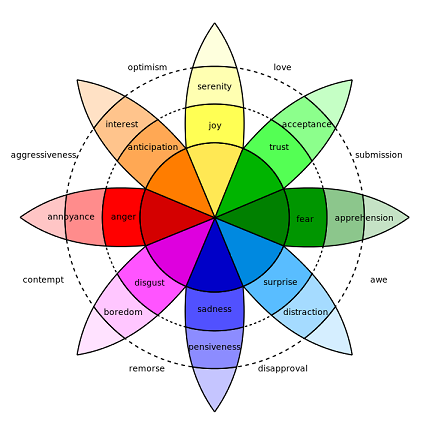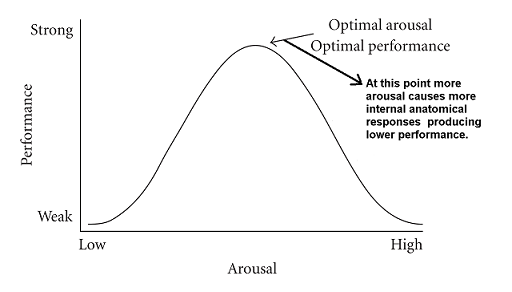Emotion and Motivation (1)
"There are two levers for moving men - interest and fear." Napoleon Bonaparte
Napoleon's quote gets to the heart of both motivation and emotion!
Welcome to the unit on Emotion and Motivation.
Watch one or both of the videos below before you continue:
Discovering Psychology Series - "Motivation and Emotion" is a 28 minute video.
The Crash course in Psychology video is less than 12 minutes.
I find that older students enjoy the Discovering Psychology video and
the younger students like the Crash course videos.
First let’s discuss emotions and then turn our attention to motivation. Why do we have emotions? From an evolutionary perspective emotions evolved to help us respond to important situations and to convey our intentions to others. Here is how an evolutionary psychologist might explain it:
In the bible, Cane was a jealous man and his brother Able was very trusting. Out of jealousy Cane killed his brother. So, the trusting emotion died with Able and the jealous emotion survived with Cane and was passed on to the next generation (Cane’s children) and all his future generations.
Emotions are a four-part process that involves subjective feelings, behavioral expression, physiological arousal & cognitive interpretation. Subjective feelings are the way YOU feel about a situation. Expressions are the outward patterns of behavior that we display when we are in the middle of an emotional episode. Physiological arousal refers to the biological changes which occur during an emotional episode. The cognitive portion is how you think about the event behind the emotion.
Emotional attributes were probably useful for survival. Those people who loved snakes picked them all up. Eventually they picked up a poisonous snake and died most likely before they had a chance to have children of their own. Those who were fearful of snakes ran away and lived to have babies who also were afraid of snakes.
Dr. Robert Plutchik (1927 – 2006) believed there were eight primary emotions. They are: anger, fear, sadness, disgust, surprise, anticipation, trust, and joy. There are 8 basic or primary emotions because he believed that each was paired with a polar opposite. He believed more emotions were developed by the blending of the basic emotions. This idea gave rise to the “emotion wheel”.

Emotional expressions are a means of communication. Interestingly facial expressions are relatively the same throughout the world. A psychologist named Paul Ekman studied facial expressions around the world and his researched revealed a universal constant in seven emotions. These seven emotions appear in all cultures – even the most primitive ones. These seven are sadness, fear, anger, disgust, contempt, surprise and happiness. Some psychologists consider other emotions as a blending of the seven basic emotions as Dr. Plutnik believed. Researchers count over 500 emotional states.
Each emotion can be expressed in varying degrees of intensity or levels of arousal. Psychologists studying arousal found that arousal and performance can be graphed together in the shape of an inverted “U”. You may think that a team should get “PUMPED UP” for an event and that - when evenly matched - the team that is the most “pumped” will win the game. The coach that can get the team the most excited “aroused” will have the best performance and win the day. However, the inverted “U” describes the relationship between arousal and performance; and shows that both low and high levels of arousal produce lower performance than does a moderate level of arousal. So, we can say that too much emotional stimulation is bad for performance. The coach that can get the team to the sweet spot and stop, will be the one that wins the day. As an aside: It is interesting that the inverted U has even shown up in economic theories such as the Kuznetz curve.

Sensation seekers
The inverted “U” is a problem for Sensation seekers who are people that are addicted to the adrenaline rush that comes when one is facing death. These people participate in extreme sports. They are putting their lives on the line, and with death on the line the person’s emotional state is extremely high and their performance suffers! These are individuals who have a biological need for higher levels of emotional stimulation than other people. These people seek out behaviors that tend toward deadly. They enjoy the sensation of facing death. Their performance levels are no different than the rest of us. So they put themselves at risk because the higher the level of emotion, the worse they will perform. When you are facing death you want to perform your best. To paraphrase part of the script from “A Princes Bride”: One should never be physically compromised when death is on the line.
The scripts of our life change depending on our culture. When a person from one culture interacts with another there can be numerous issues. Here is an example of Social/cultural responses interacting with scripts: In the United States when we find ourselves waiting in our car to turn right, and someone stops and lets us in, we wave thank you. If you are in Greece and a driver lets you in line and you give a “thank you” wave, it means “I wipe excrement on your face”. The driver will not react the way you think! The driver will not have the emotional reaction that you expect? Scripts are important and they are different between people and cultures! You need to know them when you travel abroad. Your personal/cultural script may not transfer well to another person or culture.
What Influences Emotions?
Emotions result from an interaction of social/cultural, biological, mental and behavioral processes.
Cultural has influences on emotion.
Some cultures are taught to hide emotions while others to show them. For instance: Asian cultures tend be more stoic which means non-emotional. Italian men cry when they are sad while men in the US men are told that “men don’t cry”. However, suppressing emotions can cause physiological damage. We discuss this in the unit on “stress and health”. We already discusses Scripts and how differing cultural scripts may produce differences in emotional states.
Biological connections to emotions.
There is reason to suspect that sex plays a role on emotion. For instance: the psychological pathologies of Panic Disorders and Depression are both related to emotion and they appear more often in women than in men.
What is the neuroscience (the brain) connection to emotions. Emotions respond differently depending on the parts of the brain’s anatomy that connects to it. For instance: the memory systems influence emotions. The Implicit memory system responds quickly which means emotions connected to it will also respond quickly. The fight or flight syndrome is one such emotional system. When a gunshot goes off you do not have to think about it. You react rapidly to decide if you are going to fight or run. Slower emotions may be tied to explicit memory systems and the cerebral cortex. In the biology sections we talked about the reticular activating system. It is the general arousal system of the brain. If it shuts down you go to sleep. If you speed it up you appear emotionally charged. We are all slightly different biologically. No two people are exactly the same. If a person’s RAS is more active than another, they will appear to be more emotionally charged. The limbic system controls hormone release into the blood stream. Many of those hormones affect your emotions. For instance: the Amygdala is correlated with the fear response. For instance if you are afraid of snakes and you see one, you react with fear. You run away. The hormones in your blood cause you heart rate to increase, and your breathing to increase. You are sweating and shaking. Even after you get away from the snake and know logically that you are safe, you still feel all the physiological effects of the hormones caused by the fear reaction, until they are metabolized (broken down) and removed from your system by the liver and kidneys.
It's time for a break guys, and gals.
Go get a cup of coffee.
Go do something other than study (maybe play the hangman game).
There is one crossword puzzle for the entire unit, but the hangman games are made for each slide.
Take 15 minutes or so before you go to the next slide.
Distributed learning is the best learning.
We will continue the study of Emotions in the next lecture.
Talk with you then.